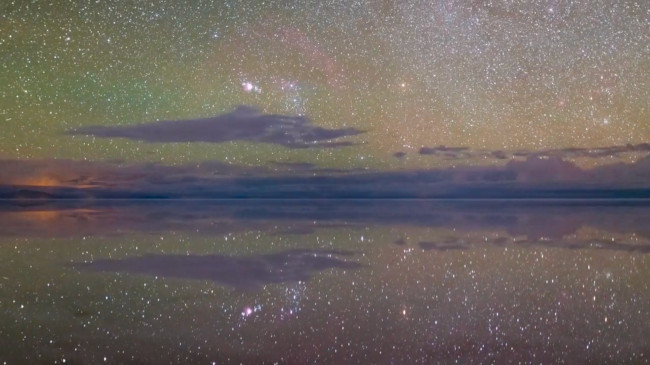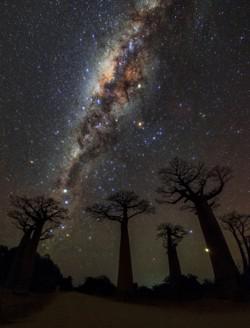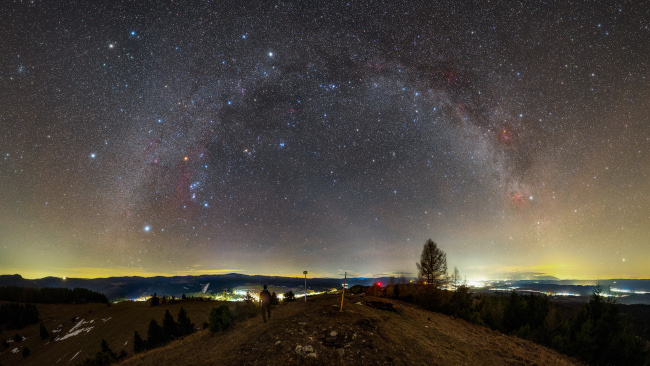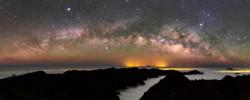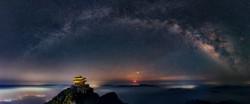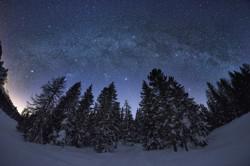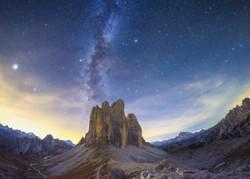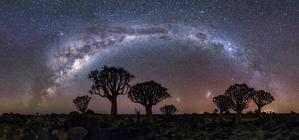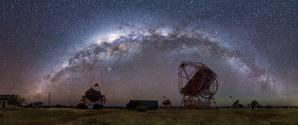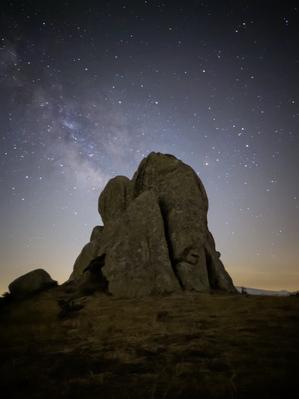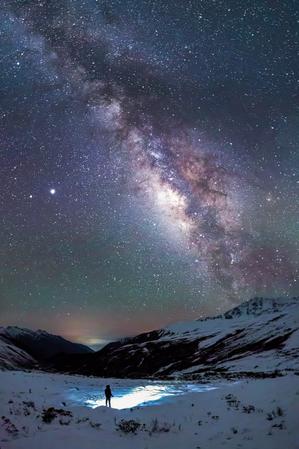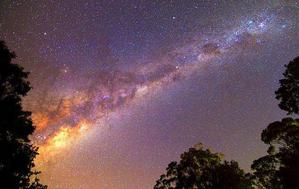Glossary term: Voie lactée
Description: La Voie lactée est la galaxie dans laquelle se trouve le Système solaire. Elle est constituée d'un ensemble d'environ 100 à 400 milliards d'étoiles. Le Système solaire est situé à environ 26 600 années-lumière du centre de la Voie lactée. Dans le ciel nocturne, nous pouvons la voir sous la forme d'une bande peu lumineuse qui s'étend sur le ciel et dont le centre se trouve dans la constellation du Sagittaire.
La Voie lactée est une galaxie spirale barrée relativement grande, dont la distribution des étoiles s'étend jusqu'à environ 100 000 années-lumière le long du disque, avec une épaisseur d'environ 1 000 années-lumière. Le disque galactique s'est formé il y a 8 à 10 milliards d'années.
Ce disque est entouré d'un halo d'étoiles beaucoup plus clairsemé, comprenant des amas d'étoiles globulaires. Ces amas globulaires comptent parmi les objets les plus anciens de la galaxie, avec un âge d'environ 12,5 milliards d'années. Outre les étoiles, la Voie lactée est composée de gaz et de poussières du milieu interstellaire et de matière noire. Alors que le milieu interstellaire se limite principalement au disque, le halo de matière noire qui l'entoure s'étend sur des distances beaucoup plus grandes que le halo stellaire.
Le centre de la Voie lactée abrite un trou noir supermassif dont la masse est environ 4 millions de fois supérieure à celle du Soleil. Autour du centre galactique se trouve un bulbe composé principalement d'étoiles plus anciennes, qui est allongé dans une direction, formant une barre.
Related Terms:
- Dark Matter
- Bulbe galactique
- Centre galactique
- Galactic Disk
- Galactic Halo
- Galaxy
- Greenwich Mean Time Zone (GMT)
- Solar System
- Interstellar Medium
- Sagittaire
See this term in other languages
Term and definition status: The original definition of this term in English have been approved by a research astronomer and a teacher The translation of this term and its definition is still awaiting approval
The OAE Multilingual Glossary is a project of the IAU Office of Astronomy for Education (OAE) in collaboration with the IAU Office of Astronomy Outreach (OAO). The terms and definitions were chosen, written and reviewed by a collective effort from the OAE, the OAE Centers and Nodes, the OAE National Astronomy Education Coordinators (NAECs) and other volunteers. You can find a full list of credits here. All glossary terms and their definitions are released under a Creative Commons CC BY-4.0 license and should be credited to "IAU OAE".
Related Media
Milky Way Arch over Lut Desert, Iran, by Amirreza Kamkar, Iran (Islamic Republic of)
Credit: Amirreza Kamkar/IAU OAE
License: CC-BY-4.0 Creative Commons Attribution 4.0 International (CC BY 4.0) icons
Constellations from the World
Credit: Stephanie Ye Ziyi/IAU OAE
License: CC-BY-4.0 Creative Commons Attribution 4.0 International (CC BY 4.0) icons
Flowing Night Sky
Credit: Robert Barsa/IAU OAE
License: CC-BY-4.0 Creative Commons Attribution 4.0 International (CC BY 4.0) icons
Chilean Nights
Credit: Robert Barsa/IAU OAE
License: CC-BY-4.0 Creative Commons Attribution 4.0 International (CC BY 4.0) icons
Le ciel de l'hémisphère Sud
Credit: Jianfeng Dai/IAU OAE
License: CC-BY-4.0 Creative Commons Attribution 4.0 International (CC BY 4.0) icons
Cen-Lup-Cru-Panorama: Centaurus Carrying the Beast and Riding Along the Milky Way
Credit: Uwe Reichert/IAU OAE
License: CC-BY-4.0 Creative Commons Attribution 4.0 International (CC BY 4.0) icons
Voie lactée au-dessus de l'Avenue des Baobabs
Credit: Amirreza Kamkar/UAI OAE
License: CC-BY-4.0 Creative Commons Attribution 4.0 International (CC BY 4.0) icons
Conduire
Credit: Marcin Zajac/IAU OAE
License: CC-BY-4.0 Creative Commons Attribution 4.0 International (CC BY 4.0) icons
Voie lactée sur le parc national d'Amboseli
Credit: Amirreza Kamkar/UAI OAE
License: CC-BY-4.0 Creative Commons Attribution 4.0 International (CC BY 4.0) icons
Les étoiles les plus brillantes du ciel
Credit: Giorgia Hofer/IAU OAE
License: CC-BY-4.0 Creative Commons Attribution 4.0 International (CC BY 4.0) icons
La Voie lactée à travers le zénith
Credit: Ohnishi Kouji/UAI OAE
License: CC-BY-4.0 Creative Commons Attribution 4.0 International (CC BY 4.0) icons
Warm Winter Night Over Spiš Region
Credit: Robert Barsa/IAU OAE
License: CC-BY-4.0 Creative Commons Attribution 4.0 International (CC BY 4.0) icons
Teide Observatory
Credit: Curd-Christian Tengeler/IAU OAE
License: CC-BY-4.0 Creative Commons Attribution 4.0 International (CC BY 4.0) icons
Oregon Coast
Credit: Marcin Zajac/IAU OAE
License: CC-BY-4.0 Creative Commons Attribution 4.0 International (CC BY 4.0) icons
Equatorial Milky Way
Credit: Giorgia Hofer/IAU OAE
License: CC-BY-4.0 Creative Commons Attribution 4.0 International (CC BY 4.0) icons
Milky Way Arch over La Palma
Credit: Amirreza Kamkar/IAU OAE
License: CC-BY-4.0 Creative Commons Attribution 4.0 International (CC BY 4.0) icons
The Moon and Milky Way arch Above the Golden Hall
Credit: Likai Lin/IAU OAE
License: CC-BY-4.0 Creative Commons Attribution 4.0 International (CC BY 4.0) icons
La voie lactée au-dessus de Anglers Reach
Credit: Lucy Yunxi Hu/IAU OAU
License: CC-BY-4.0 Creative Commons Attribution 4.0 International (CC BY 4.0) icons
Winter Milky Way
Credit: Giorgia Hofer/IAU OAE
License: CC-BY-4.0 Creative Commons Attribution 4.0 International (CC BY 4.0) icons
The Pillar of Creation
Credit: Giorgia Hofer/IAU OAE
License: CC-BY-4.0 Creative Commons Attribution 4.0 International (CC BY 4.0) icons
Lyrid of the Lake
Credit: Jianfeng Dai/IAU OAE
License: CC-BY-4.0 Creative Commons Attribution 4.0 International (CC BY 4.0) icons
Voie Lactée Au-dessus de l'Arbre à Carquois
Credit: Jianfeng Dai/IAU OAE (CC BY 4.0)
License: CC-BY-4.0 Creative Commons Attribution 4.0 International (CC BY 4.0) icons
Milky Way Over H.E.S.S Observatory
Credit: Jianfeng Dai/IAU OAE (CC BY 4.0)
License: CC-BY-4.0 Creative Commons Attribution 4.0 International (CC BY 4.0) icons
Lugu Lake Without Cloud
Credit: Liu Yang/IAU OAE (CC BY 4.0)
License: CC-BY-4.0 Creative Commons Attribution 4.0 International (CC BY 4.0) icons
The Milky Way in the Smart World
Credit: Biagio Meli/IAU OAE (CC BY 4.0)
License: CC-BY-4.0 Creative Commons Attribution 4.0 International (CC BY 4.0) icons
Milky Way Stargazer
Credit: Jianfeng Dai/IAU OAE (CC BY 4.0)
License: CC-BY-4.0 Creative Commons Attribution 4.0 International (CC BY 4.0) icons
Sailing the Celestial Seas
Credit: Lucy Yunxi Hu/IAU OAE (CC BY 4.0)
License: CC-BY-4.0 Creative Commons Attribution 4.0 International (CC BY 4.0) icons
Related Activities
Glitter Your Milky Way
astroEDU educational activity (links to astroEDU website) Description: Explore the Milky Way and characteristics of galaxies using glitter drawing.License: CC-BY-4.0 Creative Commons Attribution 4.0 International (CC BY 4.0) icons
Tags: Art , Creativity , Hands-on , Handcraft Age Ranges: 6-8 , 8-10 Education Level: Middle School , Primary Areas of Learning: Fine Art focussed Costs: Medium Cost Group Size: Group Skills: Communicating informationLiving in the Milky Way
astroEDU educational activity (links to astroEDU website) Description: Build a model of the Milky Way to discover what our galaxy contains.License: CC-BY-4.0 Creative Commons Attribution 4.0 International (CC BY 4.0) icons
Tags: Hands-on , Model Age Ranges: 6-8 , 8-10 Education Level: Primary Areas of Learning: Problem-solving , Social Research Costs: Medium Cost Duration: 1 hour 30 mins Group Size: Group Skills: Asking questions , Communicating information , Developing and using models
